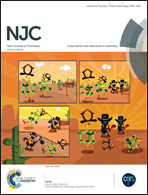Coordination chemistry of mixed M(benzene)(cyclopendadienyl) sandwich complexes: electronic properties and bonding analysis†
Abstract
DFT calculations using BP86 and B3LYP functionals have been carried out for all the low-energy structures of mixed [M(Bz)Cp]+1/0/−1 (M = Sc–Ni) sandwich complexes of benzene and cyclopentadienyl ligands. The electronic configuration of cationic, neutral and anionic metal–ligand complexes and their structures are discussed, wherein depending on the metal nature, the spin state and the metal valence electrons, a complete rationalization of the bonding has been provided for the [M(Bz)Cp]+1/0/−1 complexes. Benzene and cyclopentadienyl adopt unchanged η6 and η5 hapticities, respectively, for Sc, Ti, V, Cr and Mn complexes, but various coordination modes for Fe, Co and Ni were emphasized, according to the metal oxidation state and the complex's spin state, wherein some of them involve full or partial coordination of either benzene or cyclopentadienyl to satisfy the metal's electron demand. The ionization energy and the electron affinity showed that the neutral 19-electron iron complex is the easiest oxidized and reduced species among all the complexes studied.


 Please wait while we load your content...
Please wait while we load your content...